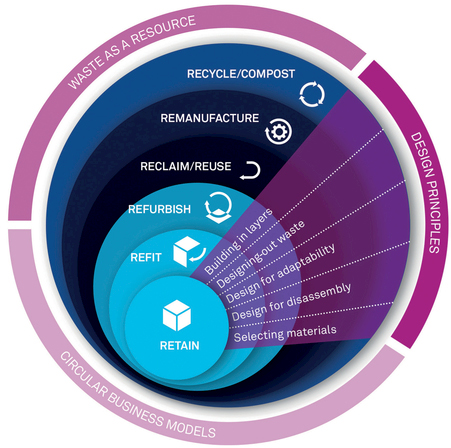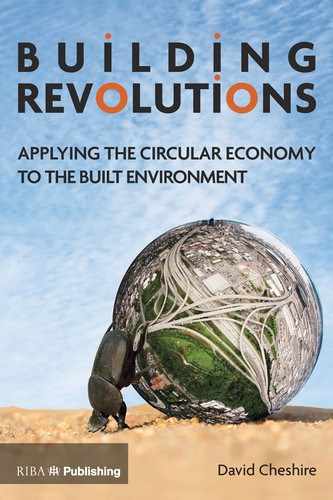05. Circular economy principles for buildings
Applying circular economy principles to the construction sector and buildings offers huge potential rewards.
Buildings can be designed to have a positive, enduring legacy by making them more adaptable and by ensuring that valuable materials and components can be reclaimed and reused at end-of-life. Ensuring that buildings can be disassembled provides the opportunity for them to be redeployed in new places or for new uses, and allows components to be salvaged and reused or remanufactured. This, in turn, reduces dependence on raw materials for construction while salvaging and remanufacturing creates local employment. Declaring and understanding the ingredients that make up materials and components will help to ensure that biological materials can be safely returned to the biosphere and technical materials can be reclaimed for reuse within industry. There is also the added benefit that the use of pure materials with the contaminants designed-out helps provide better environments in which people can live and work. Figure 5.01 summarises the principles of a circular economy when applied to buildings.

Figure 5.01: Applying circular economy principles to building design.
Concentric Circles
The nested circles show the hierarchy with the three inner circles being the most desirable. Retaining the existing building is the most resource-efficient option, followed by refits and refurbishment of existing buildings, as this retains the most resource-intensive parts of the building. For the three outer circles, the priority is to reclaim or remanufacture components, with the last option being to disassemble them to recycle back into new products or return the materials to the biosphere. This hierarchy underpins the design principles covered in this book.
Design Principles
The five segments overlaid on the circles show the design principles that can be applied to reduce waste, extend the life of the building and enable the reclamation of materials at end-of-life. These design principles are covered in Chapters 6 to 10 and summarised below:
- The idea of ‘building in layers’ recognises that the various elements of the building have different lifespans and should, therefore, be independent to allow different layers to be peeled off and replaced or salvaged without damaging the adjacent layers (see Chapter 6). This helps to create buildings that are simpler to maintain, flex or adapt, and it allows the components to be more readily reclaimed at end-of-life.
- ‘Designing-out waste’ means prioritising the refit and refurbishment of existing buildings, as this preserves the most resource-intensive elements of the building. Using reclaimed materials and remanufactured products along with leaner designs will reduce the demand for raw materials. Lastly, using modern construction techniques can avoid waste arising on site (see Chapter 7).
- ‘Design for adaptability’ means that buildings can be retained for longer. Designs have to consider how the building could be converted to other uses and how that affects the structural design and internal reconfiguration. Buildings that have proved to be adaptable have some common features, as discussed in Chapter 8, but it often seems to come down to designing buildings that are valued by people, as well as the plan form, layout and structure.
- ‘Design for disassembly’ and reuse allows components, or even whole buildings, to be reused. Chapter 9 includes an example of a building that has had three lives, being disassembled and reassembled on different sites for different purposes. This means that buildings can become assets that are independent from the value of the site and retain their value for longer. Equally, materials will have more value if they can be extracted, turning buildings into ‘materials banks’.
- Lastly, when selecting building materials and products, the constituent elements have to be known and they have to be split into biological and technical materials to allow them to be either returned to the biosphere or kept in an industrial loop of recycling or reuse (as explained in Chapter 10). The lifespan of the component should be matched to the materials selected to avoid wasting valuable resources when products are replaced long before their technical lifespan. Technical materials that are difficult to reclaim or recycle at end-of-life can be replaced with biological materials that can simply be returned to the biosphere.
New Business Models
The outer ring in the diagram represents the underlying models that can be applied to enable a more circular economy across the buildings sector.
Turning the idea of waste on its head and treating it as a resource is a fundamental principle of a circular economy. For the construction industry, this means creating a market for salvaged products and materials by using them in the design and refurbishment of buildings in preference to new ones. This, in turn, means that a detailed inventory of the constituent parts of buildings has to be created so new markets for these materials can be found before the building is stripped out or demolished. Chapter 11 explores the idea of turning buildings into ‘materials banks’ where materials are deposited and then withdrawn at a later date. There is also the potential to sell salvageable goods well in advance of demolition to create an incentive for owners and contractors to have more time to reclaim elements of the building.
The new business models move away from the linear economy approach of purchasing products, consuming them and being responsible for their maintenance, upgrade and disposal. Instead, customers and manufacturers develop longer-term relationships, with customers being able to purchase performance instead of products. This means that manufacturers have a vested interest in designing products that can be maintained, upgraded or recycled and it helps them to secure a supply of components and materials in the future. Chapter 12 looks at these new models.
Conclusion
The overarching philosophy is to put thought into the future destiny of the building and the legacy that it leaves for the next generation.
Buildings are often considered as an endowment for future generations, but all too often they become a liability that has to be demolished at a cost. Commercial buildings often depreciate over time until they have no residual value. Buildings that are valued by people do not depreciate and can often appreciate over time. By thinking about the potential future life of a building and learning lessons from the buildings that have endured, designers can create buildings that are more flexible and adaptable, giving them a longer life. Alternatively, designers can deliberately design for a short lifetime and ensure that the elements of the building can be readily disassembled and reused at end-of-life. There is even the potential to design buildings that can be demounted and reassembled in new locations and reconfigured for new uses. This is particularly relevant to organisations that experience rapid change in customer demand.
By thinking more about the whole life of the building, designers can create a lasting positive legacy for future generations, gifting them either adaptable buildings or giving them readily accessible materials and components with which to create new buildings.
